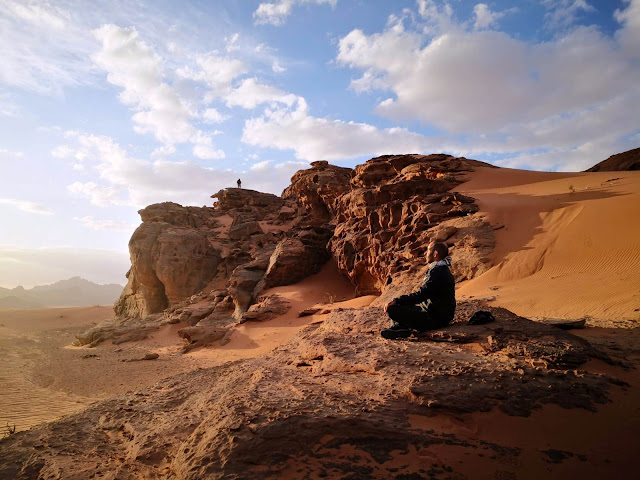Crescent Moon canyon. Indiana Jones, his father, Markus and Sallah ride through a narrow gorge in pursuit of the lost city of Alexandretta. After few meters, the majestic façade of what seems to be an ancient temple appears. Here it is supposed to be hidden the Holy Grial. I saw this scene for the first time in the cinema with 9 years old. Since then, the ruins of Petra found a place in my collection of iconic places which I would visit someday. My wishes came true on our third day in our trip, when we were lucky to visit this mythic place.
Built by the Nabateans six centuries before Christ, the ruins of this fabulous city are in Wadi Musa, four hours by bus away from Amman. Since we entered, even before passing the Siq, the spectacular canyon that precedes the entrance of the Treasury, we could appreciate the grandness of this site. Near the main gate, we can observe, for example, the Obelisk Tomb, recognizable by its four pyramids on the top, and other funerary monuments. We can also see in this are the ruins of the old dam built by the Nabateans, a very advanced civilization for its time, but which finished succumbing to the Roman empire expansion. The Siq, as I mentioned, ends in one of the most picturesque and legendary of Petra, the Treasury, with a height of 40 meters, whose inside can not be visited, and whose original function is still a mistery.
After wiping the drool, we continued our walk through the Street of Facades, a little bit wider canyon with several tombs on either side. From here we arrived at the ruins of the theatre, built by the Nabateans and remodeled by Romans. As almost all the monuments in Petra, it was carved out of rock. Ahead is the Colonnaded Street, where there were the most part of the shops in the old city. Besides are the ruins of the Great Temple, the biggest building in the whole architectural complex and, right next to it, the remains of the sanctuary dedicated to the worship of Dusahara or “Lord of the Mountain”, called Qasr al-Bint (Arabic translation of “the castle of the daughter (of Pharao)” by the Bedouins.
From this point, the way become a bit harder, so it is not a bad moment to stop for a while and rest a bit before continuing. From Qasr al-Bint to the Monastery, there is about one-hour distance by foot, passing through narrow paths and steps, with donkeys carrying visitors up and down. On either side, impressive views of cliffs and gorges. It was doubtless my favorite part since here trekking is merged with archeology and nature, the perfect combo. The final climax, once we met the great façade of the old Christian chapel, was epic and we couldn’t help but hugging due to the happiness for admiring all of that.
In the way back to the main entrance, we still had time to visit an important group of monuments, the Royal Tombs, consisting of four buildings with the Urn Tomb the most remarkable. From this point, with a stunning view beyond the Colonnade Street, you can meet a peculiar shopkeeper, who calls himself “Mohammad in the Mountains”, selling souvenirs. He was saying that we shouldn’t hesitate to publish his photo and location in Internet since he is looking for a bit of fame.
We needed just one day to see the main point of interest in Petra although, actually, I would recommend to stay at least one more day because there are a lot of alternative paths to discover. It is also possible to visit Petra at Night, but just until the gate of the Treasury, where there is a music show by candlelight. My wife loved it, but I thought that there were too many people, with group of tourists making noise and speaking loudly, which broke the magic of the moment. Anyway, it is not a bad option as appetizer, before entering this marvel which will mark you for sure.
































